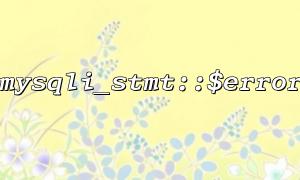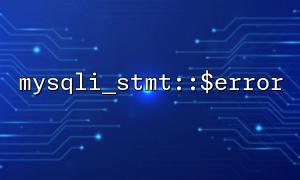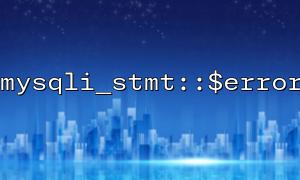In PHP, the mysqli extension provides an object-oriented way to perform database operations. The mysqli_stmt class is a tool for preparing and executing SQL statements. Good error handling is a key part of ensuring application reliability when executing SQL statements using mysqli_stmt::execute() . This article will introduce how to combine the mysqli_stmt::$error function to handle errors that may occur when executing SQL statements.
mysqli_stmt::execute() is a method in the mysqli_stmt class that is used to execute prepared SQL statements. When executing SQL, you may encounter various errors, such as syntax errors, connection problems, etc. To improve the robustness of the system, we should check and handle these errors when executing SQL statements.
<?php
// Create a database connection
$mysqli = new mysqli("localhost", "username", "password", "database");
// Check if the connection is successful
if ($mysqli->connect_error) {
die("Connection failed: " . $mysqli->connect_error);
}
// PrepareSQLStatement
$stmt = $mysqli->prepare("INSERT INTO users (username, email) VALUES (?, ?)");
// Bind parameters
$stmt->bind_param("ss", $username, $email);
// Set parameters
$username = 'john_doe';
$email = '[email protected]';
// implementSQLStatement
if ($stmt->execute()) {
echo "Data insertion successfully!";
} else {
echo "implement失败: " . $stmt->error;
}
// Close the connection
$stmt->close();
$mysqli->close();
?>
mysqli_stmt::$error is a public property of the mysqli_stmt class, which returns the error message when executing SQL statements. When executing SQL statements using mysqli_stmt::execute() , if an error occurs, mysqli_stmt::$error will contain the error message. In this way, we can catch and handle errors to ensure the stability of the application.
In the above code example, we can see how to check for errors when executing SQL statements:
if ($stmt->execute()) {
echo "Data insertion successfully!";
} else {
echo "implement失败: " . $stmt->error;
}
If $stmt->execute() is executed successfully and returns true , the insertion operation is completed and a success message is returned; otherwise, an error message is returned and an error description is obtained through $stmt->error .
In actual development, in addition to capturing the errors that fail to execute, error information can also be recorded in the log, or email notification to the developer in order to respond to system problems in a timely manner. Here is a more complete error handling example:
<?php
// Create a database connection
$mysqli = new mysqli("localhost", "username", "password", "database");
// Check if the connection is successful
if ($mysqli->connect_error) {
die("Connection failed: " . $mysqli->connect_error);
}
// PrepareSQLStatement
$stmt = $mysqli->prepare("INSERT INTO users (username, email) VALUES (?, ?)");
// Bind parameters
$stmt->bind_param("ss", $username, $email);
// Set parameters
$username = 'john_doe';
$email = '[email protected]';
// implementSQLStatement并进行Error handling
if ($stmt->execute()) {
echo "Data insertion successfully!";
} else {
// Error handling:Log logs and output error messages
error_log("SQLimplement失败: " . $stmt->error, 3, "/var/log/myapp_error.log");
echo "implement失败,Please try again later!";
}
// Close the connection
$stmt->close();
$mysqli->close();
?>
In this example, when the execution fails, the error message is not only output to the page, but also recorded in the log file, which facilitates subsequent debugging and problem tracking.
When using mysqli_stmt::execute() , combining mysqli_stmt::$error for error processing can help developers catch errors in SQL execution and promptly feedback to users or developers when problems occur. Through appropriate error handling, not only can the program be improved, but the efficiency of development and maintenance can also be improved.
Related Tags:
mysqli_stmt














